More on the Shrunken Quad
 Complete construction plans for the Shrunken Quad by KØOV are in "TRANSMITTER HUNTING---Radio Direction Finding Simplified" pages 173 to 176. Volume (airspace) of this antenna on the two meter band (146 MHz) is only one eighth that of a full-sized four element quad, making it ideal for "sniffing" out hidden transmitters on foot. Unlike a yagi, it has no sharp points, so it is safer for the user.
Complete construction plans for the Shrunken Quad by KØOV are in "TRANSMITTER HUNTING---Radio Direction Finding Simplified" pages 173 to 176. Volume (airspace) of this antenna on the two meter band (146 MHz) is only one eighth that of a full-sized four element quad, making it ideal for "sniffing" out hidden transmitters on foot. Unlike a yagi, it has no sharp points, so it is safer for the user.
Q: Does the Shrunken Quad really work? I can't get mine to tune up.
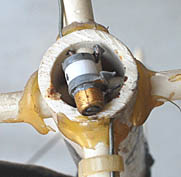 A: I have had excellent results with the Shrunken Quad and many other hams have too. I use a 6-meter version (published in my Homing In column for CQ VHF Magazine, fall 2013) every time I go mobile T-hunting on that band. The 2-meter version is still a favorite on-foot "sniffing" antenna.
A: I have had excellent results with the Shrunken Quad and many other hams have too. I use a 6-meter version (published in my Homing In column for CQ VHF Magazine, fall 2013) every time I go mobile T-hunting on that band. The 2-meter version is still a favorite on-foot "sniffing" antenna.
A high-Q antenna like this can be tricky to tune up. Carefully follow the steps in the book.
The biggest pitfall for most builders is the choice of capacitors. Ordinary air variable and ceramic trimmers are unsuitable because they go from minimum to maximum capacitance in just one half turn. This is far too coarse for this high-Q adjustment. You need a multi-turn trimmer, usually called a "piston" capacitor because the rotor screws in and out of the cylindrical stator like a piston.
However, not just any old piston trimmer will do. The easiest ones to find are the kind that look like an open ceramic tube about a half inch long with plating on inside and outside. A screw with rather coarse thread goes in and out. Builders have discovered that these don't work either, probably because the adjustment is still too coarse.
The correct ones to use are about 1/4 inch in diameter and 1/2 inch long, completely enclosed in ceramic and brass, as in the photo below. They have a constant-torque drive with very fine thread. It takes 11 turns of the tuning tool to cover the the full capacitance range on the ones I use. The piston and bellows are internal and the whole thing is sealed, so moisture/water won't upset the tuning.

Q: Where can I get the right piston trimmer capacitors?
A: I built my quads with capacitors made by Johanson Manufacturing Corporation. That line of trimmers is now made by Knowles Precision Devices. You can buy new ones by mail-order from Mouser Electronics of Mansfield, TX. Prices start around $38 each.
Johanson Model 5453 16 pF piston trimmers are available from Skycraft Surplus at (407) 628-5634 (SKU 023107).
Surplus capacitors are available from Dan's Small Parts and Kits at (801) 515-6373. When I checked recently, there was only one suitable trimmer type in his stock, so choose carefully.
Q: I can't tune the antenna because my screwdriver changes the tuning it when it gets close.
A: You need to use a completely non-metallic tuning tool if possible. Plastic tools with a small metal bit at the end will also work. See the photo below for suitable tools.
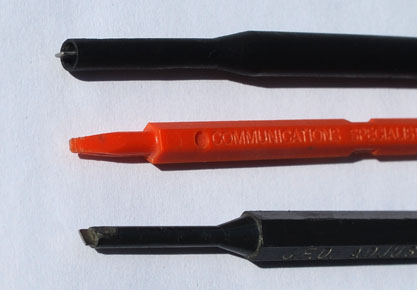
Q: I don't understand the balun. Do I need it?
A: Yes. The balun on the Shrunken Quad is of the "bazooka" or "sleeve" type,
which consists of an extra length of braid, an electrical quarter wavelength
long, placed over the antenna end of the RG-58 coax feedline. The sleeve is
connected to the RG-58 shield only at the end closest to the receiver input. The antenna end of the sleeve is left open.
Here's how to build the balun for two meters: Make a quarter-inch cut in the feedline jacket
12.9 inches from the antenna end, exposing the braid there. (Don't remove the
entire foot of jacket---just a little quarter-inch circle of it.) Now take
some braid from old coax, smooth it down over the outside jacket on that last
12.9 inches and connect it to the shield at the point where you cut the
jacket. Leave the other end open. Put tape or shrink sleeving over the added
braid to prevent shorts.
For more information on sleeve baluns, see the "Linear Baluns" section in the
"Transmission Lines" chapter of a recent ARRL Handbook. Note that classic
bazooka designs require the sleeve to be spaced away from the coax shield to
form a sort of special transmission line. That would be the optimum way to
make such a balun for precision work, but the method in the book is entirely
adequate for close-in sniffing with a two-element antenna.
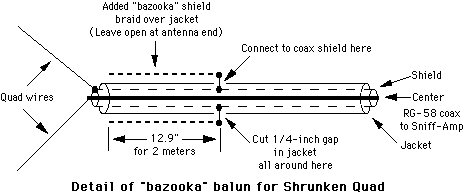
Q: How critical are the dimensions?
A: Don't worry about getting element lengths precisely correct. A
quarter or half inch difference probably won't matter. This is not like a
conventional quad, where element resonant frequency is determined almost
entirely by circumference. In the Shrunken Quad, resonance is determined by
both the element circumference and the value of the loading capacitance. There
is enough range in the trimmer capacitors to make up for minor variations in
element circumference. In fact, there is so much range that some builders have
accidentally mistuned their quads such that the reflector became a director, so
the quad worked backwards! When they re-tweaked the trimmers, the quad worked
normally.
For frequencies outside the two-meter ham radio band, scale the element circumference and spacing dimensions given in the book by the ratio of the frequencies. For instance, for the 223 MHz band, the dimensions would be 146/223 or two-thirds of the two-meter dimensions. Scale the bazooka balun length also.
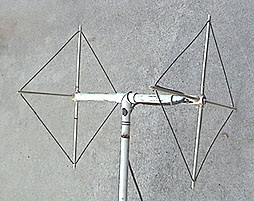
I rebuilt my original Shrunken quad using 1/4-inch diameter fiberglass spreaders (covered with shrink sleeving) and 3/32-inch bronze welding rod elements. It is now extremely rugged and has
withstood lots of tramping in the brush.
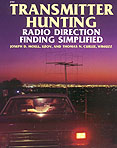
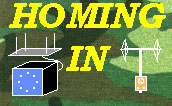 Back to the Homing In home page
Back to the Homing In home page
This page updated 12 July 2025
 Complete construction plans for the Shrunken Quad by KØOV are in "TRANSMITTER HUNTING---Radio Direction Finding Simplified" pages 173 to 176. Volume (airspace) of this antenna on the two meter band (146 MHz) is only one eighth that of a full-sized four element quad, making it ideal for "sniffing" out hidden transmitters on foot. Unlike a yagi, it has no sharp points, so it is safer for the user.
Complete construction plans for the Shrunken Quad by KØOV are in "TRANSMITTER HUNTING---Radio Direction Finding Simplified" pages 173 to 176. Volume (airspace) of this antenna on the two meter band (146 MHz) is only one eighth that of a full-sized four element quad, making it ideal for "sniffing" out hidden transmitters on foot. Unlike a yagi, it has no sharp points, so it is safer for the user. A: I have had excellent results with the Shrunken Quad and many other hams have too. I use a 6-meter version (published in my Homing In column for CQ VHF Magazine, fall 2013) every time I go mobile T-hunting on that band. The 2-meter version is still a favorite on-foot "sniffing" antenna.
A: I have had excellent results with the Shrunken Quad and many other hams have too. I use a 6-meter version (published in my Homing In column for CQ VHF Magazine, fall 2013) every time I go mobile T-hunting on that band. The 2-meter version is still a favorite on-foot "sniffing" antenna.





